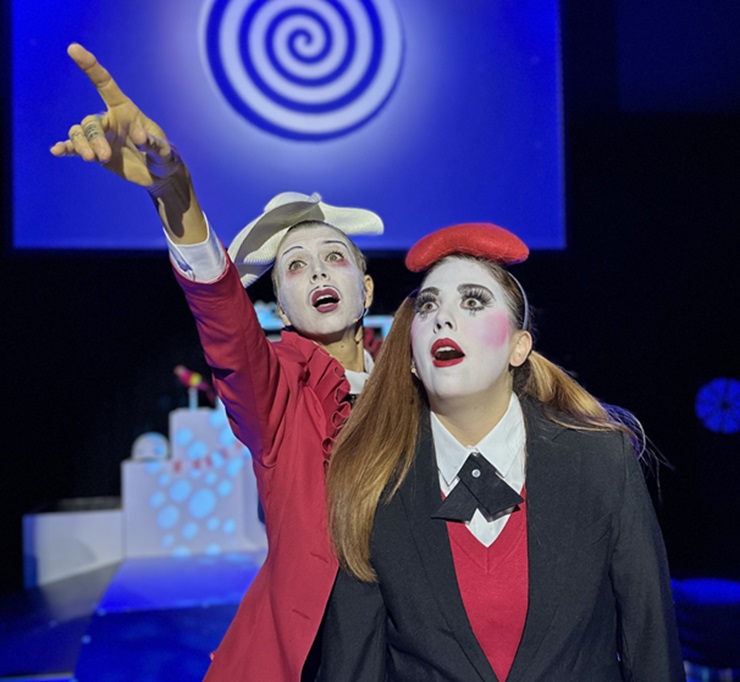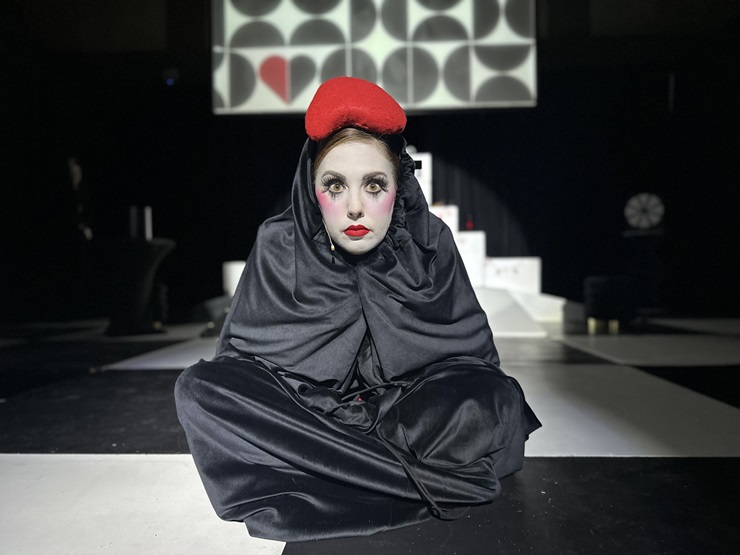
Isidore (Autumn Kioti Horne) acts as teacher to what she perceives as her submissive pupil, Leopold, (Leah Sessa) in Thinking Cap Theatre's production of "Tango Palace" now in the Broward Performing Arts Center's Abdo New River Room in Fort Lauderdale through Friday, Nov. 3. (Photo by Nicole Stodard)
One of the beauties of the play, Tango Palace, is that audience members can each take away something different, and none of the patrons would necessarily be “right” or “wrong.”
Indeed, this layered, engaging 1963 experimental, absurdist piece about a struggle between two people is open to interpretation. But this much is certain: You will think a lot before, during, and after witnessing the piece by the late feminist groundbreaking playwright Maria Irene Fornes (1930-2018).
What, exactly, is she trying to say, you may scratch your head and ask? So, it makes sense that South Florida’s Thinking Cap Theatre (TCT), a daring professional, nonprofit company, would stage the essentially plotless, character-driven play, "Tango Palace."
TCT’s triumphant production runs through Friday, Nov. 3 in Ft. Lauderdale. In addition to the performance Thursday, Nov. 2, audiences will can be part of a post-show talkback. Leading it will be Nicole Stodard, Ph.D. She is a scholar, the production’s director, and TCT's artistic director. The topic will be “Fornes’ Living Legacy: TCT’s Embodied Research and Rehearsal Practices.”

Renaissance painter Sandro Botticelli's "St. Sebastian" looms over Isidore (Autumn Kioti Horne) and Leopold (Leah Sessa). (Photo by Nicole Stodard)
The tango began as a dancing duel, a display of bravado between men. The dancing style, which originated in Argentina’s brothels, developed into a sensual entanglement between a man and a woman.
TCT’s production doesn't convey the passion of the tango. Indeed, in place of sultriness, TCT’s mounting is playful albeit sinister.
That is appropriate because Fornes has written the piece as an experimental, absurdist play with similarities to Samuel Beckett's "Waiting for Godot." In fact, in the play, Fornes reveals her indebtedness to Beckett’s absurdism, Oscar Wilde’s wit, and a modern camp style. Fornes’ one-time lover, Susan Sontag, captured that style in her landmark essay, “Notes on Camp.”
By the way, absurdism is a belief that human existence is chaotic and meaningless. Further, “Theater of the Absurd” refers to a style of theater that represents the absurdity of human existence in a meaningless universe. Today, in our dark and chaotic world, some may feel that life has lost meaning. With this in mind, the time is right to stage such a piece as "Tango Palace" or "Waiting for Godot."
Basically, Godot concerns a couple of tramps searching for purpose and meaning in a universe seemingly devoid of them. And in "Tango Palace," earnest youth Leopold and androgynous clown Isidore are characters similar to Godot’s tramps.
Indeed, Leopold and Isidore essentially sit around, play games, argue, and physically struggle with each other.
In fact, Isidore seems intent on establishing himself (herself in TCT’s production) as the dominant figure.
Meanwhile, Leopold, trying to maintain some sense of dignity, rejects the humiliation and powerlessness that this sado-masochistic struggle affords the less-dominant figure. Undoubtedly, the “dance” that these characters engage in is literally a dance to death.
Theater companies have staged "Tango Palace" as a battle between a man and woman and a struggle between two men. However, no company has mounted the play as a war between two women – until now. By casting two women, the fearless TCT delivers a female-empowering message. It suggests that a woman can be a strong, even domineering figure. Such traits are not limited to the male sex.
Casting two women in the roles also makes sense for another reason. In particular, the prolific Fornes’s relationship with writer Susan Sontag (1933-2004) may have inspired this play.

Autumn Kioti Horne as Isidore and Leah Sessa as Leopold in Thinking Cap Theatre's wonderful two-character play in the intimate Abdo New River Room at the Broward Center for the Performing Arts through Friday, Nov. 3. (Photo by Nicole Stodard)
The playfulness of TCT’s production is evident from the start, entering the theater.
It is the Abdo New River Room located at the Broward Center for the Performing Arts in Ft. Lauderdale, TCT’s new home.
Indeed, the stage is essentially a series of boxes or boards that you might find at an amusement park. Playing cards that serve a useful purpose in the production rest on some of the platforms.
Upstage is a throne-like chair. It may suggest that somebody will prove to be the royal, dominant figure in the upcoming battle.
As the play unspools, under Stodard's assured direction, this is not a completely one-sided struggle. Rather, Leopold demonstrates moments of strength, and we might find our allegiances shifting between the two characters.
Intimate moments exist between the two characters, and they are believably passionate.
The vintage projection clips that play before the show starts may give us an idea of what we can expect. The clips feature dancing women, visitors to a zoo seemingly singing to animals, as well as singing and dancing during a snowball fight.

Capturing one of the more tender moments between Isidore (Autumn Kioti Horne) and Leopold (Leah Sessa) in Thinking Cap Theatre's production of "Tango Palace" now in the Broward Performing Arts Center's New Abdo River Room through Friday, Nov. 3. (Photo by Nicole Stodard)
Suddenly, a phone shrills. Then, the lights come up, and the show (struggle) begins.
As Isidore, Autumn Kioti Horne is believably playful, dramatic, and commanding without turning the character into a shrew, which could be a trapping of this role.
Clearly, Kioti’s Isidore is in charge here, and the performer is assertive. They wield, among other things, a whip.
As Leopold, Leah Sessa is the more submissive of the two. However, she is firm when Leopold needs to be. To convey frustration, apathy, and stubbornness, Sessa mostly folds her arms and wears a pouting expression. However, Sessa could find more ways to express Leopold’s impatience and exasperation with Isidore.
On a brighter note, Leopold says, “I feel such pain for being here,” and we sense the character's anguish through Sessa’s expressive voice.

Leah Sessa as Leopold in Thinking Cap Theatre's production of Maria Irene Fornes' tantalizing "Tango Palace." (Photo by Nicole Stodard)
As two performers working together, Horne and Sessa, both sporting clownish white makeup, demonstrate strong chemistry; both wear similar, striking costumes designed by Stodard.
The outfits are pleasing visually and allow the performers to move easily.
In the lighting department, TCT Managing Director Bree-Anna Obst focuses the performers properly while using colors such as red wisely. Some inventive additions, including a lightning-like effect, bring energy to the production.
South Florida audiences may have seen TCT’s production of "Fefu & Her Friends," a 1977 play also by Fornes (the playwright penned "Tango Palace," her first play, in late 1962).
TCT’s believable and playful production of "Fefu & Her Friends," presented during the summer of 2022 at Mad Arts in Dania Beach, likely introduced audiences to one of Fornes’ hallmarks – site-specific theater. In fact, she was an originator of site-specific theater, or theater performed outside traditional theatrical spaces. Also, Fornes was a pioneer of the 1960s Off-Off Broadway movement.
Fornes blossomed into a recognized force in Hispanic-American and experimental theater in New York. It is the kind of theater that you are not likely to find outside of metropolises such as New York. So, take advantage of TCT’s bold offerings by experiencing its smartly acted and directed production of "Tango Palace."
You’ll be glad that you did; you are not likely anytime soon to encounter another company willing to tango with this riveting play.
Thinking Cap Theatre's production of "Tango Palace" runs through Friday, Nov. 3 in the Abdo New River Room located at the Broward Center for the Performing Arts, 201 S.W. Fifth Ave. in Ft. Lauderdale. Talkbacks after some performances. $45 for general admission; $20 for student rush tickets at the door (age 21 and younger with valid student ID). Information at (954) 610-7263 or thinkingcaptheatre.org.




